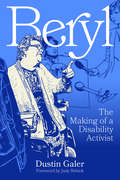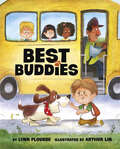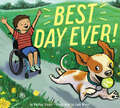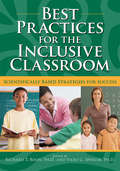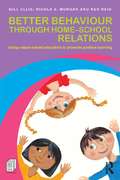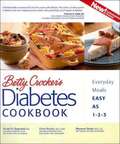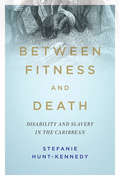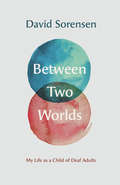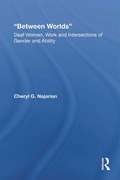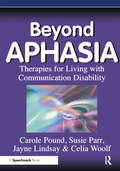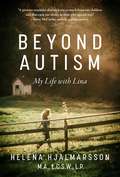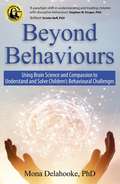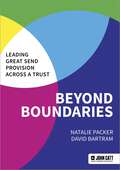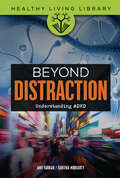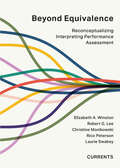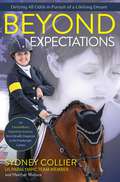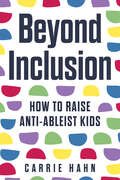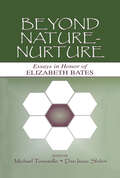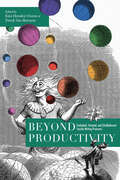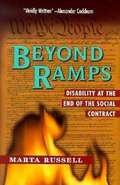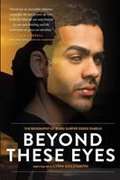- Table View
- List View
Beryl: The Making of a Disability Activist
by Dustin GalerBeryl Potter was a reserved working-class mother of three living a decent life, or so it seemed, when a harmless slip and fall marked the unravelling of everything that she had known about herself and the world around her. Over the course of six years, she endured unimaginable pain. As doctors raced to save her life, her limbs and eyesight were taken from her one by one. In the span of a few years, she lost nearly half her body, her financial security, her home, her husband, and any semblance of a recognizable future. A survivor of more than one hundred surgeries, a dangerous opioid addiction, and multiple suicide attempts, Beryl Potter devoted herself to bettering the lives of other people with disabilities and made a tremendous contribution to disability awareness from the 1970s to 1990s. In this unparalleled biography, Dustin Galer demonstrates how Beryl Potter seemed to crack the code of the social system that oppressed her. By wading into the weeds of her complicated life before and after her accident, Galer leaves readers with a complex portrait of a woman who defied and challenged gender and disability norms of her time, paving the way for disability justice.
Best Buddies
by Lynn PlourdeBest Buddies introduces a boy-and-dog duo who are BEST FRIENDS and who do EVERYTHING together! So how will they manage being apart when the boy heads to school for the first time? Find out how a clever boy with Down syndrome and his loyal pet find the perfect way to feel close even when they can’t be together. A sweet, inspiring story that will ease concerns about the first day of school and other big changes for kids.
Best Day Ever!
by Marilyn SingerA sweet dog-loves-kid/kid-loves-dog story, in which the kid uses a wheelchair, from an award-winning children&’s poet and talented debut illustrator.This playful puppy thinks she&’s having the best day ever! She's so happy to be out with her friend, she doesn't even realize that she's being a little naughty. But then he scolds her, and suddenly—Worst. Day. Ever. Will puppy be able to make amends and turn their day back around? Join an exuberant, boundary-pushing pup and her exasperated boy in this reassuring story about unconditional love and the challenges of trying to always be on your best behavior.
Best Practices for the Inclusive Classroom
by Vicky G. Spencer Richard T. BoonScientifically based strategies for sucess in the classroom.
Better Behaviour through Home-School Relations: Using values-based education to promote positive learning
by Nicola S. Morgan Gill Ellis Ken ReidHow can we create effective partnerships between home, school and the community? How can the relationships and communication between families and school be strengthened? How can families help schools to improve behaviour in their children, both at home and at school? Using a tried and tested framework that has been successfully implemented throughout a wide variety of very different schools and settings, ‘Family Values’ is a Scheme which engages and empowers families to work in close collaboration with schools and organisations, and which results in long-term improvements in behaviour, communication, pupil achievement and relationships. The ‘Family Values’ Scheme has been proven to: Help pupils to be more academically diligent Help schools to assume a calmer, more peaceful ambience Forge better pupil-teacher relationships Improve Pupil and teacher wellbeing Help parents to be more engaged with the school Improve children’s literacy, behaviour and attendance Provide head teachers and their staff with an effective whole-school strategy. The authors’ award-winning ‘Family Values’ Scheme is underpinned by sound theoretical principles, and they show here how it has been successfully put into practice through case studies in real school settings. The book explores how the Scheme promotes social, emotional and family system theories, and, in linking effectively to SEAL (social and emotional aspects of learning), the Scheme compliments existing personal and social education programmes in all schools. Showing schools and organisations how to create effective partnerships with families and the community in a fun, exciting and sustainable way, Better Behaviour through Home-School Relations will be of huge benefit to all school staff, as well as local authorities, support groups, parents, charities and services.
Betty Crocker's Diabetes Cookbook: Everyday Meals, Easy as 1-2-3
by Betty CrockerFrom the book: No matter what type of diabetes you have, the diagnosis can feel overwhelming. You may have questions about what you can or should eat and whether there are some foods you have to give up altogether-that's where this book can help. Betty Crocker, teamed with diabetes experts from the International Diabetes Center, has created an all-in-one diabetes resource, filled with delicious recipes and up-to-the-minute medical and nutrition information. Here's great news about diabetes: The best- kept secret of diabetes food planning is that it's good for everyone. You may think that people with diabetes need special foods prepared special ways, but as you look through this book, you'll find a wide variety of delicious and satisfying foods that you can eat-and that the whole family will enjoy. This book is designed to make meals easy. It's our first cookbook to count Carbohydrate Choices for every recipe, following the latest guidelines of the American Diabetes Association. You'll also turn to this book for its easy-to-follow health information, from an explanation of the types of diabetes to a nutrition primer and a medical resource guide. The section "Diabetes Care: It's in Your Hands" empowers you to understand your care process. The goal is to help you feel in control of your diabetes, instead of letting diabetes control you. Throughout, you'll find plenty of encouragement. There's real-life advice from people with diabetes, as well as parents of kids with diabetes and other caregivers who deal with diabetes day in, day out. Finally, you'll find a week's worth of delicious menus, complete with breakfast, lunch, dinner and snack ideas, followed by a glossary of medical, nutrition and other diabetes terms. As a source for recipes and so much more, Betty Crocker's Diabetes Cookbook will become your all-in-one diabetes resource. Richard M. Bergenstal, M.D., executive director of the International Diabetes Center, is an endocrinologist at Park Nicollet Clinic in Minneapolis, and clinical professor of medicine at the University of Minnesota. He did his medical and endocrine training at the University of Chicago, where he was a member of the faculty before joining the International Diabetes Center's renowned patient-centered care team. He has served as a principal investigator in key research studies in type 1 and type 2 diabetes, defining the importance of good blood glucose control in preventing the complications of diabetes.
Between Fitness and Death: Disability and Slavery in the Caribbean (Disability Histories #12)
by Stefanie Hunt-KennedyLong before the English became involved in the African slave trade, they imagined Africans as monstrous and deformed beings. The English drew on pre-existing European ideas about monstrosity and deformity to argue that Africans were a monstrous race, suspended between human and animal, and as such only fit for servitude. Joining blackness to disability transformed English ideas about defective bodies and minds. It also influenced understandings of race and ability even as it shaped the embodied reality of people enslaved in the British Caribbean. Stefanie Hunt-Kennedy provides a three-pronged analysis of disability in the context of Atlantic slavery. First, she examines the connections of enslavement and representations of disability and the parallel development of English anti-black racism. From there, she moves from realms of representation to reality in order to illuminate the physical, emotional, and psychological impairments inflicted by slavery and endured by the enslaved. Finally, she looks at slave law as a system of enforced disablement. Audacious and powerful, Between Fitness and Death is a groundbreaking journey into the entwined histories of racism and ableism.
Between Two Worlds: My Life as a Child of Deaf Adults
by David SorensenIn his memoir, David Sorensen explores his identity as a coda, or a child of Deaf adults. He describes his experiences with the roles often placed on codas at a young age, such as interpreter, confidant, and decision-maker. His story reveals a person seeking acceptance and belonging while straddling the Deaf and hearing worlds, and shows how he found reconciliation within himself and with both worlds. Sorensen relays the dynamics of his family life; he had a strained relationship with his father, who was an active leader and role model in the Deaf community and the Mormon Church, yet struggled to bond with his own son. Sorensen rebelled as a youth and left home as a teenager, completely detaching from the Deaf community. After struggling to establish himself as an independent adult, he discovered that he wanted to return to the Deaf world and use his ASL fluency and cultural understanding as a mental health therapist and community advocate. Now he considers himself an ambassador between the Deaf and hearing worlds, as well as between the older and younger generations of Deaf people. Between Two Worlds: My Life as a Child of Deaf Adults shares the unique experiences of a coda and passes on the rich cultural past shared by the American Deaf community.
Between Two Worlds: My Life as a Child of Deaf Adults (Gallaudet Studies In Interpret Ser. #17)
by David SorensenIn his memoir, David Sorensen explores his identity as a coda, or a child of Deaf adults. He describes his experiences with the roles often placed on codas at a young age, such as interpreter, confidant, and decision-maker. His story reveals a person seeking acceptance and belonging while straddling the Deaf and hearing worlds, and shows how he found reconciliation within himself and with both worlds. Sorensen relays the dynamics of his family life; he had a strained relationship with his father, who was an active leader and role model in the Deaf community and the Mormon Church, yet struggled to bond with his own son. Sorensen rebelled as a youth and left home as a teenager, completely detaching from the Deaf community. After struggling to establish himself as an independent adult, he discovered that he wanted to return to the Deaf world and use his ASL fluency and cultural understanding as a mental health therapist and community advocate. Now he considers himself an ambassador between the Deaf and hearing worlds, as well as between the older and younger generations of Deaf people. Between Two Worlds: My Life as a Child of Deaf Adults shares the unique experiences of a coda and passes on the rich cultural past shared by the American Deaf community.
Between Worlds: Deaf Women, Work and Intersections of Gender and Ability (New Approaches in Sociology)
by Cheryl G. NajarianThe purpose of this book is to illustrate the struggles of Deaf women as they negotiate their family, educational, and work lives. This study demonstrates how these women resist and overcome the various obstacles that are put before them as well as how they work to negotiate their identities as Deaf women in the Deaf community, hearing world, and the places 'in between.' The scope of the book traces these women's lives in these three major sectors of their lives and provides a discussion of the implications for other linguistic minorities.
Beyond Aphasia: Therapies For Living With Communication Disability (Speechmark Editions)
by Carole Pound Jayne Lindsay Susie Parr Celia WoolfThis book focuses explicitly on therapeutic techniques developed from a social model approach to disability and learning to live with difference. It describes theories, activities and methods of implementation developed from the work of Connect with people with long term aphasia. "Theoretical discussion runs alongside practical ideas for therapy and evaluation, case studies and commentaries from the authors regarding the method and means of implementation." Synthesises theory and practice in this new area of service delivery. Its non-impairment led focus of the therapies means that it has wide appeal to therapists, health service professionals and volunteers who work with people with chronic disabilities affecting lifestyle and communication.
Beyond Arm’s Reach: Enhancing Distance Vision
by Audrey J. Smith Lizabeth M. O'DonnellThis book is designed to enhance distance visual efficiency for children with low vision, and includes 4 chapters, with 64 sequential lessons.
Beyond Autism: My Life with Lina
by Helena HjalmarssonA Passionate Memoir about Life with a Teenage Daughter with Severe Autism, Following the Progress of Acclaimed Book, Finding Lina. Like her passionate first book, Finding Lina, about her daughter with severe autism, Helena Hjalmarsson brings an intensity of purpose and love to her second memoir about Lina, Beyond Autism. Lina’s world is one of excruciating challenges. Helena’s world is the same, but with her own insights, indominable spirit, and amazing clarity she sheds light and hope for other parents, siblings and caretakers of children with autism, as well as the children with autism themselves. She unflinchingly examines “the paradoxical nature of autism, the never-ending mystery of who our children are and how they got here, in the middle of this unfathomable hurricane of leaky guts, inflammation, yeast, autoimmune disorders, seizures, sensory breakdown, loss of words, physical freedom, sleep, friends, normal life as we are used to refer to it.”Beyond Autism is one of an increasing number of “you are not alone” literary statements from parents of children with autism forwarded to the people whose lives, similarly, often blocks the view of the larger community. Beyond Autism is intended to be a meeting place, of sorts. A smile of recognition. A reason for a little dark joke amongst parents.What Helena recognizes is that whenever Lina is not in mayhem, she is in heaven. “In those times she seems so free of the burdens of a past and a future, so deeply present and accepting of the moment …Whenever she is not suffering, it seems to me that she is at that enlightened, awakened place that most people struggle for a whole life time to catch a glimpse of.” It’s that glimpse that Helene explores, and shares for all those who want, too, to catch and gain insight into the lives of those with autism and those who love them.
Beyond Behaviours: Using Brain Science and Compassion to Understand and Solve Children's Behavioural Challenges
by Mona DelahookeA PARADIGM SHIFT FOR CAREGIVERS THAT WILL REVOLUTIONIZE THE WAY YOU APPROACH, TREAT OR PARENT A CHILD WITH CHALLENGING OR EXPLOSIVE BEHAVIOURS. When you are confronted with a child who is troubled, disruptive, oppositional, defiant or angry - whether you are a parent or a teacher - it can be difficult to know the best way to support them. Traditional methods of 'shaping' a child's behaviour can often be at best ineffective, at worst distressing, for child and adult alike.Drawing on 30 years of experience, internationally known paediatric psychologist Dr Mona Delahooke describes these troubled behaviours as the 'tip of the iceberg', important signals that point to deeper, individual differences in the child that we need to understand and address before we can resolve behavioural challenges. Using the very latest neuroscientific research Beyond Behaviours makes the case that many children who can't seem to behave simply don't have the developmental capacity to do so - yet. This book uses neuroscientific findings to help you deconstruct behaviour challenges, and to discover their cause and triggers for your child. It will show you how to apply this knowledge across a variety of behaviour spectrums, from children diagnosed with autism or other forms of neurodiversity, to those who might have been exposed to toxic stress or trauma during their early years. There are practical strategies to implement at every stage, backed up by impactful worksheets and charts, with a strong emphasis not on 'managing' behaviour, but instead on helping children and families build positive experiences to counteract the stress and pressure felt by everybody when you're working, or living, with a child who has behavioural challenges. Accessible, practical, warmly supportive and steeped in research and clinical expertise, Beyond Behaviours offers a break-through book which guides us - parents and caregivers alike - to the realisation that the most important tool in our toolkit is always our connection with the child standing in front of us.
Beyond Boundaries: Leading Great SEND Provision across a Trust
by David Bartram NATALIE PACKERBeyond Boundaries provides a model for effective trust leadership of SEND. It includes a range of case studies that highlight the many successes trust leaders have achieved so that learners with SEND in their schools are able to flourish.Structured around the Primary Colours Model of Leadership, the book considers six key elements of leadership through the lens of SEND:· Set the strategic direction· Create alignment· Build and sustain relationships· Create teams· Plan and organise· Deliver results and get things done.Primarily aimed at leaders within trusts, this book will also be relevant for those leading SEND provision in a range of school groups and networks.
Beyond Boundaries: Leading Great SEND Provision across a Trust
by David Bartram NATALIE PACKERBeyond Boundaries provides a model for effective trust leadership of SEND. It includes a range of case studies that highlight the many successes trust leaders have achieved so that learners with SEND in their schools are able to flourish.Structured around the Primary Colours Model of Leadership, the book considers six key elements of leadership through the lens of SEND:· Set the strategic direction· Create alignment· Build and sustain relationships· Create teams· Plan and organise· Deliver results and get things done.Primarily aimed at leaders within trusts, this book will also be relevant for those leading SEND provision in a range of school groups and networks.
Beyond Distraction: Understanding ADHD (Healthy Living Library)
by Tabitha Moriarty Amy FarrarAttention Deficit Hyperactivity Disorder (ADHD) is the second most impactful condition on young people’s health in the United States. But ADHD is a complex disorder and is often misunderstood or stereotyped as just a few symptoms. ADHD may present with many different symptoms. Social factors such as age can also affect how the disorder manifests. Recognizing the breadth and complexity of ADHD helps people not only support someone with the disorder but also understand what their options are if they are diagnosed. This timely guide explains the causes, symptoms, and diagnosis of ADHD and covers ongoing research into the disorder, coping strategies, and treatments such as therapy options and medication. Find out more about ADHD and gain resources for understanding, treating, and living with it in Beyond Distraction.
Beyond Equivalence: Reconceptualizing Interpreting Performance Assessment
by Robert G. Lee Christine Monikowski Elizabeth A. Winston Laurie Swabey Rico PetersonThere is a longstanding need for valid, reliable measurements of interpreting competence. Although rubrics and checklists are commonly used in both academic and employment settings, a review of available rubrics indicates that many do not focus on interpreting performance. Traditional metrics for sign language interpreting often conflate language proficiency with interpreting proficiency. Conflating fundamental aspects of language in use—vocabulary, grammar, and prosody— with fundamental aspects of interpretation—content, intent, and monitoring—compromises the valid assessment of interpreting proficiency. Beyond Equivalence: Reconceptualizing Interpreting Performance Assessment argues for a shift toward more nuanced and evidence-based conceptualizations of interpreting, communication, and meaning to improve the creation and use of rubrics for assessment in interpreter education, certification, and professional development. This inaugural volume in the Currents series introduces a rubric and accompanying scale, which can be used to assess both simultaneous and consecutive interpreting performance in terms of both process and product, in both signed and spoken language interpreting, and in a variety of settings. Beyond Equivalence offers an appreciation of the multivarious nature of meaning in the interpreting process and presents a new paradigm for the measurement of interpreting proficiency.
Beyond Expectations
by Heather Wallace Sydney CollierA memoir that captures a young athlete's battle with a devastating diagnosis and the courage and perseverance that has propelled her to the top of a Paralympic sport.For seven years, Sydney Collier enjoyed the life of a happy, active child, with caring, supportive parents and siblings. She ran through sprinklers and played with neighborhood friends. And she fell in love with four-legged animals, especially horses. Her mother encouraged her to ride, and Sydney was good at it, finding herself at home in the saddle.Then a routine eye exam changed everything.Sydney had the incredibly rare Wyburn-Mason Syndrome, a congenital birth defect that causes arteriovenous malformations where the veins and arteries in the brain don't separate as they should through capillaries. The resulting &“clumps&” of veins and arteries have increased blood flow and a high risk of aneurysm, and they tend to affect the brain, eye, and facial structures. Fewer than 100 cases of Wyburn-Mason Syndrome have been reported, according to the National Institute of Health, and its rarity means treatment remains controversial and prognosis uncertain. Most diagnoses in infants have been confirmed by pathologists after death.Wyburn-Mason began to take an immediate toll on Sydney's body, first with its effect on her vision, and soon severe physical debilitation and excruciating migraines. Over the next eight years, as she and her family tried treatment after treatment, seeking some sort of hope, the only place where Sydney could escape the almost-constant pain for just a little while was on the back of a horse.During a risky brain surgery in 2009, Sydney suffered a devastating and massive stroke, which inflicted a new level of disability, putting her in a wheelchair. Determined to ride horses again, Sydney entered a rehabilitation center and refused to give up on her goal of one day riding at the high-performance level for the United States. A year later, on a trip with her mother to the World Equestrian Games in Kentucky, Sydney had a chance to watch the sport of Para Dressage, and that moment helped finally turn what seemed an overwhelming tide of loss and suffering. A new goal was born: to become a competitor in the Paralympics, and to do it in partnership with the only thing that brought her peace and happiness—horses.This is the story of a brave young woman's journey from the doctors' offices to medal podiums, in her words. Anyone looking for a reason to believe that dreams can be realized, regardless of the odds, will find motivation in these pages.
Beyond Inclusion: How to Raise Anti-Ableist Kids
by Carrie Cherney HahnIf the question is "How do you raise anti-ableist kids?" the answer is "Become anti-ableist and then model it through intention and action for your children." Parents want to be inclusive of their disabled and neurodivergent neighbors and want to pass these values along to their children. What holds them back is not having the education or experience on how to appropriately do this. Beyond Inclusion breaks down fifteen common forms of ableism, with explanations, examples, and first-person accounts. Doing better starts with knowledge. Author Carrie Cherney Hahn offers activities and perspectives that help parents understand the ableism that exists within them and supports their ability to process and dismantle it so that they can model anti-ableist practices for their kids. Each chapter offers children's resources that parents can use to nurture informed and anti-ableist ideals in their kids.Inclusion is actually the bare minimum. Our work is to show our children how to become more understanding, more accepting, and more appreciative of disabled and neurodivergent people.
Beyond Nature-Nurture: Essays in Honor of Elizabeth Bates
by Michael Tomasello Dan Isaac SlobinBeyond Nature-Nurture: Essays in Honor of Elizabeth Bates is a very special tribute to the University of California at San Diego psycholinguist, developmental psychologist, and cognitive scientist Elizabeth Ann Bates, who died on December 14, 2003 from pancreatic cancer. Liz was a force of nature; she was also a nurturing force, as is evidenced by this collaborative collection of chapters written by many of her closest colleagues and former students. The book covers a brilliant career of wide-ranging interdisciplinary interests, such as the brain bases of language in children and adults; language and cognitive development in normal and neurologically impaired populations of children; real-time language processing in monolinguals and bilinguals; and crosslinguistic comparisons of language development, language use, and language loss. In this volume the contributors provide up-to-date reviews of these and other areas of research in an attempt to continue in the directions in which she has pointed us. The genius of Bates is founded on a deep dedication to science, supported by an enduring sense of humor. The volume is introduced by the editors' collection of "Bates's aphorisms," the wisdom of which guide much of the field today: "[T]he human capacity for language could be both innate and species-specific, and yet involve no mechanisms that evolved specifically and uniquely for language itself. Language could be viewed as a new machine constructed entirely out of old parts." (Bates & MacWhinney, 1989) The volume also contains a list of her many important publications, as well as some personal reflections of some of the contributors, noting ways in which she made a difference in their lives. Beyond Nature-Nurture: Essays in Honor of Elizabeth Bates appeals to international scholars in the fields of developmental psycholinguistics, cognitive science, crosslinguistic research, and both child and adult language disorders. It is a state-of-the-art overview of many areas of cognitive science, and can be used in a graduate-level classroom in courses designed as seminars in any of these topics.
Beyond Productivity: Embodied, Situated, and (Un)Balanced Faculty Writing Processes
by Kim Hensley Owens Derek Van IttersumIn Beyond Productivity, a wide range of contributors share honest narratives of the sometimes-impossible conditions that scholars face when completing writing projects. The essays provide backstage views of the authors' varying approaches to moving forward when the desire to produce wanes, when deciding a project is not working, when working within and around and redefining academic productivity expectations, and when writing with ever-changing bodies that do not always function as expected. This collection positions scholarly writers' ways of writing as a form of flexible, evolving knowledge. By exhibiting what is lost and gained through successive rounds of transformation and adaptation over time, the contributors offer a sustainable understanding and practice of process—one that looks beyond productivity as the primary measure of success. Each presents a fluid understanding of the writing process, illustrating its deeply personal nature and revealing how fragmented and disjointed methods and experiences can highlight what is precious about writing. Beyond Productivity determines anew the use and value of scholarly writing and the processes that produce it, both within and beyond the context of the losses, constraints, and adaptations associated with the COVID-19 pandemic.
Beyond Ramps: Disability at the End of the Social Contract
by Marta RussellThe Social Contract -- Rousseau's famous term concerning the bond between a government and its people -- has been sold to the highest bidder. Freedom is reserved only for markets in a society increasingly strangled by corporate power. "Empowerment" is the new definition of destitution. By looking at the struggles of the disabled faced with the end of social services, Ending the Social Contract as We Know It provides a powerful warning: the disabled are as canaries in a coal mine, and their maltreatment is a harbinger of things to come for the rest of us. In a tightly woven argument, Marta Russell shows how the onslaught of corporate power facing the disabled -- from issues like genetic screening, to restricted access to health care, to welfare reform -- will shortly be faced by a much broader segment of society.
Beyond These Eyes: The Biography Of Blind Surfer Derek Rabelo
by Lynn Goldsmith"If I can do all this and I am blind, what can you achieve?" Beyond These Eyes is the biography of one of the most inspiring, courageous and incredible young men to be living on our planet at this time in history. Professional surfer Derek Rabelo is fearless in the ocean. The unique characteristic of this young man, though, is that he is blind, having been born with congenital glaucoma. He is famous for his big wave courage, riding life-threatening monsters at Pipeline, Jaws and Mavericks in Northern California, and most recently surfing 50 foot waves in Nazaré, Portugal. This is an unbelievable attempt for anyone, but a miracle if you are blind. Beyond These Eyes takes you on an extraordinary journey of Derek's life. From the time of his birth, the anguish and then devotion and love of his family, to his time now as a married man and his devotion to his wife, Madeline. His strong faith and love for God has enabled him to achieve the miraculous. Derek tours the world to speak to people of all ages to encourage and inspire them to take the limitations off their thinking.
